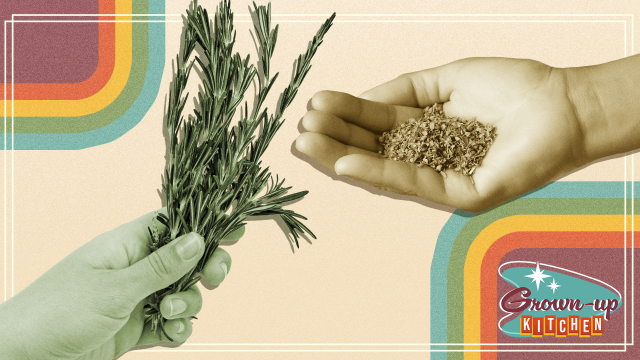Salt and (good) pepper can get you pretty far in your cooking, but true grown-up cooks use an arsenal of herbs and spices to flavour their meals. How you stock your spice cabinet will depend on the type of cuisine you want to enjoy—a “basic” Anglo spice cabinet is quite different from an East Asian one—but knowing how to use herbs, whether dry or fresh, will make you a better, more versatile cook.
These ratios work for most herbs
In most cases, a tablespoon of fresh herbs packs the same amount of flavour as a teaspoon of dried, which translates to a ratio of three parts fresh for one part dried. This is due to the fact that fresh herbs contain water, which doesn’t contribute any flavour, but adds bulk. If a recipe calls for 2 tablespoons of fresh, minced basil, you’ll need 2 teaspoons of dried basil flakes.
Ground herbs are even more potent; use a ratio of four parts fresh for one part ground. If a recipe calls for a teaspoon of ground oregano, you’ll need 1 tablespoon plus 1 teaspoon of the fresh, minced sage leaves.
Give ‘em a sniff
These rules only apply if you’re working with dried herbs that are relatively, uh, fresh (freshly purchased, that is). If that jar of dried thyme has been hanging out in your spice cabinet for a while, give it a sniff. If it has a strong aroma, you’re good to go. If it doesn’t smell like anything, toss it. If it smells like a ghost of its former self, you can still use it, but I would recommend only doing so in recipes that allow you to season “to taste,” so you can adjust as needed. (I personally like to use herbs and seasonings that have lost their lustre as popcorn seasoning; popcorn is a forgiving canvas.)
Sage is tricky
Did you know there are two types of sage? Dried and rubbed. I’ve explained the differences before, but let’s recap:
Ground sage is made from leaves that have been dried and ground into a fine powder, stems and all; rubbed sage is made by rubbing the dried leaves (no stems) together into fluffy little bits. Grinding breaks down the leaves more completely, resulting in a more intensely flavored and slightly more astringent, pungent, and bitter product, with notes of mint and citrus and a more pronounced earthy flavor. Rubbed sage is a little gentler, with a piney sweetness, a hint of earthiness, and almost no bitterness.
Due to its fluffy nature, rubbed sage takes up twice as much space as its ground counterpart, so you will need double the amount to get the same result. Conversely, if your recipe calls for rubbed sage, but all you have is ground, just use half the amount called for in the recipe.
Avoid dried parsley
Most dried herbs can be used to flavour sauces, soups, stews, and all sorts of dishes just fine. While personal preference plays a role—I have a friend who cannot stand dried oregano—there is one dried herb that is largely pointless: dried parsley. Dried parsley is the La Croix version of its fresh self, a mere suggestion of herbiness that you can only detect if you squint your tongue.
Fresh makes the best garnish
When using herbs in a raw preparation, either in a salad or as a garnish, it’s best to avoid dried entirely. The texture is just all wrong; those little desiccated flakes will feel like paper confetti on the tongue. Fresh ribbons of basil are heavenly on a pizza, but dried basil flakes won’t do your pie any favours.

Leave a Reply
You must be logged in to post a comment.